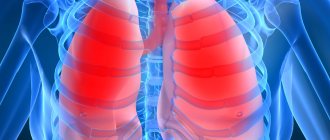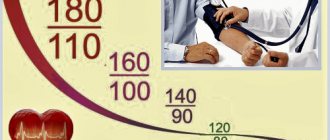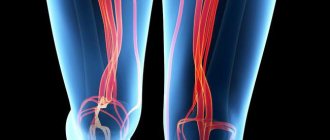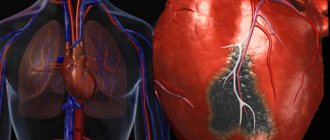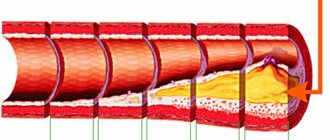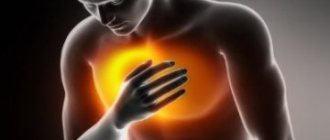It is known that coronary heart disease is an increasing and irreversible process, no matter what medications it is treated with. Today, ischemic heart disease is recognized as the most common cause of sudden death, as well as one of the leading causes of mortality in the population in general terms (30%).
Considering the fact that this disease is increasingly being diagnosed in working citizens (45–50 years old), surgical treatment of IHD can be called a truly life-saving method of restoring a person’s ability to work.
Indications for surgical treatment
Since it is impossible to restore the lumen of an artery narrowed by atherosclerotic (cholesterol) plaque with drugs, surgical treatment of coronary artery disease, in theory, should be recommended to all patients with such a diagnosis without exception.
However, heart surgery requires a number of conditions. When determining indications for surgical treatment of coronary artery disease, the following main factors must be taken into account:
- the severity of angina pectoris and its resistance (immunity) to drug treatments, that is, the clinical picture of ischemia;
- anatomical data on the damaged coronary bed - the location and degree of damage to the coronary arteries, the type of their blood supply, the number of damaged vessels;
- contractile function of the heart muscle;
- patient's age.
Among these conditions, the last 3 are of greatest importance, since the probability of surgical risk and the prognosis of the disease without surgical intervention depend on these factors. Evaluation of these factors allows us to determine the feasibility or futility of surgical methods for treating coronary artery disease. Indications for surgical treatment of ischemia are:
- numerous injuries to the coronary arteries;
- the presence of trunk stenosis in one of the arteries;
- the presence of narrowing of the orifices of the right and left coronary arteries.
Surgical treatment of coronary heart disease is not performed if the following contraindications are present:
- less than 4 months after the heart attack;
- when the myocardium is weakened by severe heart failure;
- with reduced contractile function of the heart muscle (with ejection fractions <0.3);
- with numerous diffuse damage to the peripheral coronary arteries.
Let's look at surgical methods for treating coronary artery disease in more detail.
Indications for surgical treatment of coronary artery disease
Angioplasty and stenting of coronary arteries
Until recently, one of the most commonly used methods of surgical treatment of coronary artery disease was the minimally invasive technique of percutaneous balloon angioplasty, which has lost its relevance today. The reason is that the effect is too short-term and unstable. Later, this technique was supplemented by a procedure that allows maintaining the effect of expanding the lumen of the vessel for many years - stenting, and became one of the most popular methods of restoring the arterial lumen.
Description of the method
The technique for stenting the coronary arteries is almost identical to balloon angioplasty, the only difference being that a small transformable metal mesh frame called a stent is mounted at the end of the balloon, which is inserted into the patient through a vein.
- First, the patient receives a sedative or local anesthesia.
- Then a special conductor is inserted through the patient's femoral vein - a catheter - through which a radiopaque substance and a stent are delivered to the narrowed artery.
- The entire operation is carried out under the control of X-ray equipment. When the stent is opposite the atherosclerotic plaque, it begins to expand using an inflatable balloon to the size of the vessel.
- The design of the stent rests on the walls of the vessel and keeps them in an expanded state.
Efficiency
To enhance the effectiveness of the procedure, more and more modern types of frames are being developed from high-quality materials - stainless steel or special alloys. Today a wide variety of stents are produced:
- not requiring balloon expansion (self-expanding);
- with a special polymer coating that releases a drug in doses to prevent restenosis (re-narrowing);
- innovative models of stents - scaffolds, characterized by biological solubility and a low probability of restenosis, which are completely absorbed 2 years after surgery.
The latest types of stents are somewhat more expensive, but are more effective.
Possible complications
Surgical treatment of coronary heart disease using stenting successfully restores normal arterial blood flow in 90% of cases without causing any complications. But in rare cases, negative consequences are still possible. They may appear:
- bleeding;
- violation of the integrity of the arterial walls (vessel dissection);
- problems with kidney activity;
- the occurrence of hematomas at the puncture site;
- myocardial infarction;
- thrombosis or restenosis of the stenting area;
- rarely (<0.05%) - fatal.
It is extremely rare that an artery may become blocked, causing the patient to require urgent coronary artery bypass surgery (5 cases per 1000).
Result of coronary artery stenting
Stenting
It is a unique way to normalize blood circulation to and from the heart. Under normal conditions, it is supplied with blood from the coronary arteries arising from the aorta. Not far from each artery is a coronary vein, which drains blood from the heart. With coronary artery disease, the coronary artery is blocked by plaque. It obstructs blood flow but does not affect the veins. The essence of the intervention is to create a channel between the coronary blood vessel and the narrowed lumen of the artery with a special catheter.
Intra-aortic balloon pumping is usually performed through the femoral artery
The operation lasts 2 hours without anesthesia. The lumen of the blood vessel that carries blood from the heart muscle to all parts of the body is restored by inserting a stent. This is a mesh tube made of metal. X-rays are used to determine the location of the stent opposite the plaque. An inflatable balloon expands the tube. All manipulations are carried out through the femoral vein using a catheter. Local anesthesia is used, so the patient is aware of what is happening to him and follows the doctor’s commands. The success of the intervention is related to the quality of the tube materials. There are stents that expand on their own, and some even release drugs themselves after insertion. The operation restores the lumen of the blood vessel, normalizes blood flow and eliminates pain. But atherosclerosis cannot be completely cured, so it is imperative to follow preventive measures. A common complication after surgery is the reappearance of the plaque. In this case, the operation is repeated. For stable IHD, drug therapy is indicated instead of surgery.
Coronary artery bypass surgery
As noted above, there are situations when angioplasty and stenting are impossible, most often due to severe stenosis of the coronary artery. Then the surgical treatment of coronary artery disease involves a technique that has been developed over decades - coronary artery bypass grafting (CABG), or suturing a “bypass” to the coronary artery.
Description of the method
Without a doubt, the method of coronary artery bypass can be called the most radical way to restore blood circulation in the artery.
The essence of the method is to create an additional “tunnel” on the damaged artery for blood flow from a piece of the patient’s own vein or artery (anastomosis).
The material is taken mainly from the great femoral vein or the radial vein, as well as from the aorta of the forearm.
Today, 3 types of CABG are practiced:
- On a patient's heart that has stopped and is connected to artificial circulation.
- On the patient's active heart, without IR connection. This technique reduces the risk of complications, shortens the duration of the procedure and, as a result, speeds up postoperative recovery. This technique can only be performed by surgeons with extensive experience.
- Recently, they are increasingly resorting to a minimally invasive (with minimal dissection) technique, used both on a beating heart and on a stopped heart with IR connection. It is characterized by less blood loss, a decrease in the number of infectious complications, and a shorter postoperative rehabilitation period.
Efficiency
If we talk about the effectiveness of this type of surgical treatment of coronary artery disease, then it can be called the most optimal method that can solve the problem of blood supply in both single and multiple damage to the arteries. CABG has the highest rates of positive surgical outcomes and achievement of sustainable results.
Possible complications
Any surgical intervention, especially something as radical as coronary artery bypass surgery, involves a risk of complications. Coronary artery bypass grafting can be complicated by:
- deep vein thrombosis;
- bleeding;
- development of atrial fibrillation or myocardial infarction;
- cerebrovascular disorder;
- narrowing of the shunt (bypass vessel);
- wound infection, formation of keloid scars;
- systematic pain at the incision site and other pathologies.
To be fair, it is worth noting that such situations do not happen often.
Stages of coronary bypass surgery
Coronary artery bypass grafting
Coronary heart disease is the main cause of death in people of working age. The essence of the intervention is to completely normalize the process of blood supply to the heart and the movement of blood through arteries with a narrowed lumen. The coronary arteries and the main artery are connected by shunts.
This is a standard operation for blockages of the coronary arteries.
If IHD is diagnosed, indications for intervention are as follows:
- angina pectoris refractory to drug therapy;
- complications from myocardial infarction;
- heart failure;
- ventricular arrhythmias;
- atherosclerosis.
Surgery is performed on patients aged 30 to 55 years. In older people, atherosclerosis also affects other arteries. Usually the number of shunts does not exceed five. An artificial heart-lung device is used.
For bypass surgery, the great saphenous vein (GSV), located in the legs, is used. Its length ranges from 65 to 75 cm. The doctor isolates it and bandages it. Then he carefully cuts it off. Due to the high percentage of closure of venous shunts after the end of manipulation, arteries (radial, thoracic) are more often used for the material. Arterial and venous shunts are used for bypass surgery. The effectiveness of the procedure increases with the use of anterior shunts. But such an operation must be performed by a highly qualified specialist and is expensive, and the recovery period takes a long time.
During surgery, your heart is temporarily stopped and your body is connected to a machine called a heart-lung machine.
External counterpulsation method
In situations where none of the above methods can be used for various reasons, non-invasive therapy for coronary artery disease is proposed in the form of external counterpulsation technique. This technique does not apply to the types of surgical treatment of coronary artery disease, but it is often used in the preoperative period, as well as during postoperative rehabilitation (after 1–2 weeks). And, of course, as a therapeutic agent for damage to small branches of the coronary arteries that cannot be stented or bypassed.
Description of the method
The essence of this method is a forced increase in diastolic pressure in the aorta and an increase in perfusion coronary pressure with subsequent unloading of the left ventricle at the moment of compression (systole) of the myocardium.
The effect of counterpulsation on the myocardium leads to a decrease in its oxygen demand, increased cardiac output and coronary circulation in general.
How is the procedure performed?
- The patient is placed on the couch, electrocardiograph electrodes are connected to the chest, the data of which is displayed on the monitor.
- The patient's arms, legs and thighs are wrapped in pneumatic cuffs (similar to a tonometer).
- A sensor is installed on one of the fingers to measure the pulse and display blood flow in the arteries; it also measures the level of oxygen saturation in the blood.
- This entire system works synchronously with the electrocardiogram - at the moment of diastole (relaxation of the myocardium and its saturation with blood), air is consistently pumped into the cuffs. Thanks to this, a blood wave directed towards the heart is formed.
- At the moment of systole (contraction of the myocardium and ejection of blood into the aorta), the cuffs are sharply released from air, simply deflated, which helps to increase blood flow in the vessels and facilitate the work of the heart.
Numerous studies have shown that this method of non-surgical treatment of coronary artery disease is most effective with a therapeutic course of 35 hours (one hour-long manipulation per day for 4-7 weeks).
Cardiac shock wave therapy method
Manipulations associated with cardiac shock wave therapy (CSWT) also refer to a method of non-invasive, that is, non-surgical treatment of coronary heart disease. But this method has the right to be considered in our article, since it is also used to treat complications of coronary artery disease after surgery. And such cases, according to various sources, number 10–30%.
Today, it is still difficult to predict the short-term and long-term prospects of coronary artery disease surgery aimed at direct revascularization (restoration of the vascular system) of the myocardium.
Patients suffering from various forms of conduction and rhythm disturbances, myocardial contractile dysfunction, infarction and post-infarction aneurysm of the left ventricle, widespread cardiosclerosis and other complications are forced to resort to repeated surgery.
Another option is to use the possibilities of drug treatment, which condemns the patient to a painful existence in the limited space of a home or hospital.
The CUVP technique can significantly improve the quality of life of a patient who has undergone surgical treatment of coronary artery disease, and is considered the most promising and dynamically developing method of conservative therapy.
Procedure
The CUVP procedure is painless, performed on an outpatient basis and does not require anesthesia.
- The patient is placed on the couch, and a device with a cardiac sensor, operating on the principle of ultrasound equipment, is pressed to his chest.
- The generation of shock waves occurs in the container of the therapeutic head filled with water; they are transmitted to the patient through a flexible membrane.
- The emission of shock waves is synchronized with the ECG in the refractory phase of the cardiac cycle with a targeted effect on the ischemic area.
- Exposure to acoustic shock waves promotes stimulation of local angiogenesis factors, which is manifested by the formation of new vascular branches in the coronary blood flow system.
- The total duration of the CUVP course is about 12 weeks. The frequency and duration of each procedure is agreed with the doctor, usually 10 sessions of 30 minutes each with breaks of several days.
After the CUVP procedure, the patient goes home and goes about his usual activities.
Drug groups
Coronary heart disease is a chronic disease of the coronary vessels.
Its treatment consists of taking medications to prevent complications and correcting lifestyle, especially body culture and food. The protocol includes the prescription of drugs that prevent the development of heart attack or cardiosclerosis. Patients with coronary artery disease have a number of concomitant pathologies, including arterial hypertension (hypertension), rhythm disturbances (arrhythmias), diabetes mellitus and heart failure. Each of the above diseases requires monitoring by a specialized doctor within the time period established by the protocol (on average, once every six months). Due to the “long” diagnosis, patients with ischemia take from 4 to 7 tablets per day, which is not comfortable, but necessary. Modern drugs make it possible to include up to 3 active ingredients in one pill (polypill technology), which simplifies the pill regimen, increasing patient adherence to treatment.
The average person with coronary artery disease will have the following list of mandatory medications to take on a regular basis: a statin, an antiplatelet agent, an ACE inhibitor, a beta blocker. At the choice and discretion of the doctor, cardiometabolics can be added to such a plan, but Western cardiological practice does not approve of their use (more precisely, not all).
Antiplatelet agents are drugs that prevent blood cells from sticking together into a thrombotic mass. Another important property of drugs in this group is the prevention of attachment of formed elements to the inner wall of the vessel. The main cause of ischemia is an atherosclerotic plaque, which becomes dangerous after the formation of a blood clot on its surface. This is associated with the process of blockage of the vessel and disruption of the perfusion of heart tissue with oxygen. Disaggregants affect the pathogenesis of heart attack and other complications, which is why they are taken regularly and constantly.
Examples of drugs:
- "Aspirin". Main analogues: “Aspirin Cardio”, “Cardiomagnyl”.
- Clopidogrel is prescribed after coronary artery bypass surgery or percutaneous coronary intervention. The drug prevents thrombosis, the patient takes it for at least 1-2 years after the intervention.
- Warfarin is used for fibrillation and situations associated with an extremely high risk of thrombotic problems. Among all blood thinning drugs, it has the highest incidence of bleeding (a side effect of antiplatelet agents). Requires INR monitoring under constant supervision of a cardiologist (for the first six months - every month).
- “Xarelto” (rivaroxaban), “Dabigatran”, “Pradaxa” are modern drugs, the purpose of which is to reduce the high risk of bleeding when taking drugs of previous generations. Most of them have proven their effectiveness in studies, although they are not ahead of Warfarin in this parameter. But a significant reduction in the incidence of blood loss made it possible to include them in the list of drugs of choice for patients requiring long-term antiplatelet therapy.
Beta blockers. Every patient diagnosed with coronary artery disease must take a ß-block, because this drug will reduce the consumption of oxygen, which is so lacking in myocardial cells depleted by ischemia. The medicine acts on beta-adrenergic receptors and reduces the heart rate, slowing down the rhythm and saving muscle resources. Their constant use significantly increases the life expectancy of a patient with ischemia.
Discontinuation of the drug occurs with a gradual reduction in dose down to a minimum. The reason for such actions is withdrawal syndrome - a situation when a sudden refusal to use a medicine causes a worsening of the patient’s condition.
Preparations:
- "Metoprolol", "Betalok";
- "Bisoprolol", "Concor", "Coronal";
- "Carvedilol", "Coriol", "Talliton";
- “Nebivalol”, “Nebilet”, “Nebivalol Sandoz”, “Nebil”.
Angiotensin-converting enzyme inhibitors. This group inhibits the enzyme that converts the inactive form of angiotensin I into working angiotensin II. This is important because it is the second that leads to vasospasm in order to increase pressure in the renal arteries. The drugs are first-line drugs in the treatment of hypertension and have pronounced nephroprotective properties.
Preparations:
- "Lisinopril", "Diroton", "Combipril";
- "Enalapril", "Enap", "Enam", "Berlipril";
- "Captopril", "Capoten", "Captopres";
- “Ramipril”, “Ramizes”, “Hartil”, “Tritace”;
- "Perindopril", "Prenessa", "Prestarium".
- "Zofenopril", "Fosinopril".
Statins affect the condition of the vascular wall and the metabolism of lipoproteins (cholesterol). These drugs for the treatment of coronary heart disease are fundamental - they, along with antiplatelet agents, prolong the life of patients with atherosclerosis. The doctor recommends taking statins if there are abnormalities in the lipid profile or if the patient has a poor cardiovascular risk in the next 10 years. Medicines should be taken every day, at night, regularly monitoring liver biochemistry indicators (statins affect the functioning of the hepatocellular apparatus).
The drugs in this group stop the development of atherosclerotic plaques and relieve the inflammatory process on their surface. Moreover, the drugs slow down the formation of new fatty elements in the vessel wall.
Preparations:
- "Simvastatin";
- "Atorvastatin";
- "Lovastatin";
- "Rosuvastatin".
Fibrates (“Fenofibrate”) are used to treat dyslipidemia, primarily targeting triglycerides, unlike statins, which target lipoproteins. Area of use: often hereditary diseases of the liver parenchyma. They are poorly tolerated by patients and have many reactions to use.
Nitrates. The effect of the drugs is vasodilation of venous vessels and blood deposition. As a result, the preload on the myocardium is significantly reduced.
This effect provokes a decrease in blood pressure, a decrease in oxygen consumption by the heart, and dilation of the coronary vessels.
Nitrates do not change life expectancy, but successfully remove an attack of angina pectoris. In severe conditions, medications are administered intravenously. Among modern drugs there are substances that have a long-term effect (mono- and dinitrate). Their bonuses: less aggressive lowering of blood pressure, the ability to take once a day, an easy version of the course of typical headaches.
Preparations:
- "Nitroglycerine";
- "Isosorbide mononitrate";
- “Monosan”, “Nitrosorbide”, “Effox Long”, “Kardiket”, “Isoket”, “Izomic”.
Diuretics require careful use, as they are extremely harmful and negatively affect the balance of electrolytes in cells. Despite this, the agents are widely prescribed because they rid tissues of unnecessary extracellular fluid. For ischemic heart disease, diuretics are prescribed for the following purposes:
- Hypotonic effect. Medicines are added to ACE inhibitors or sartans as an adjuvant. It is more convenient to use a calcium channel blocker as a secondary prescribed drug due to its pronounced effect. For the purpose of antihypertensive action, pre-diuretic doses of diuretics are often used (half the standard ones).
- Prevention of congestive processes in CHF - high doses are prescribed, it is allowed to take several drugs at the same time (two, three).
It is worthwhile to carefully prescribe diuretics to patients with diabetes. They often have chronic kidney disease, so the patient's glomerular filtration rate must be determined before using the medication.
Loop diuretics - Furosemide, Torasemide, Lasix - are used in tablets and injections. They are used for forced diuresis because they have a quick and pronounced effect.
Thiazide and thiazide-like diuretics are drugs prescribed for long-term use as a treatment for hypertension. These include “Hypothiazide”, “Indapamide”, “Hydrochlorothiazide”, “Xipamide”.
Which surgical method is most optimal?
Despite the likelihood of complications, all of the above options for surgical treatment of coronary heart disease are highly effective and significantly improve the patient’s quality of life. The most radical and effective method is coronary artery bypass grafting (CABG).
To carry out a particular operation, it is necessary to have a number of indications, as well as the absence of contraindications.
Therefore, the choice of surgical treatment method for coronary artery disease, be it angioplasty, stenting or coronary artery bypass grafting, should be made taking into account the individual characteristics of each patient.
In this regard, it is inappropriate to recommend any of these methods as the most optimal for all patients without exception.


